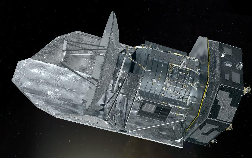 |
| OOV |
Research and technical projects |

|
Current projects
Modelling of Irradiated Molecular Clouds
Project C1 of the SFB 956: Conditions and Impact of Star Formation - Astrophysics, Instrumentation and Laboratory Research collects the theoretical and modelling efforts to understand the radiative impact from young stars on their environment. We develop a model for the surfaces of molecular clouds affected by UV radiation from young stars, so-called photon-dominated regions. It will allow to interpret the far-infrared observations of star-forming regions and determine the role of radiative triggering of star-formation.
Comparing turbulent structures in models and observations
In the DFG-funded ISM-SPP and GENESIS projects we systematically compare statistical properties of large scale mapping observations of ISM clouds in the different tracers with simulated observations based on turbulence models. In this way we try to identify critical physical processes governing the cloud structure. A major focus falls on the phase transition from atomic to molecular gas at cloud boundaries and other chemical transitions.
Carbon fractionation in PDRs
Based on a Herschel Guaranteed Time program and subsequent SOFIA/GREAT observations we study the chemical fractionation in photon-dominated regions through the reaction 13C+ + CO → 13CO + C+. By accurately measuring the abundance of 13C isotopologues, we try to confirm the predicted fractionation structure in PDRs. Observations of 13C+ rather allowed to measure optical depths of the main idotope line. Best results for fractionation are obtained from 13CH.
The CARMA-NRO-Orion Survy
Motivated by planning the science cases for CCAT-p we started some large scale mapping to show the diagnostic powers of megapixel spectral cubes. CARMA and NRO observations of CO, 13CO, and C18O 1-0 from Orion have been taken and combined. First data are published but the extreme richness of information in the data cubes promises continued work for several more years. This is complemented by new SOFIA/GREAT mappings of the [CII] fine structure line that will allow to trace the radiatiive excitation in the region.
SimLine
My program to simulate the line radiative transfer in molecular clouds has been presented in detail in Ossenkopf, Trojan & Stutzki (2001). It is currently extended by Thomas Möller to include the effects of infrared continuum pumping through interstellar dust and the modelling of a full spectral-energy distribution from line and continuum emission.
CCAT-p
We are major partners in the 6m submm telescope under construction at the Cerro Chajnantor at an altitude of 5600m. Currently, I am contributing and in the software development group covering the topics of quality assurance, observing modes, testing, and instrument interfaces.
Past projects
WADI
In the Herschel key project we performed FIR spectroscopy of the "Warm And Dense ISM" to improve our understanding of the physical and chemical processes controlling the interaction between stars and their environment. The program covered 136h of Herschel time and the results are still analysed by a large international consortium of more than 30 members. Observational results have been published in a number of papers.
HEXOS
The Herschel guaranteed time program "Herschel/HIFI Observations of EXtraOrdinary Sources: The Orion and Sagittarrius B2 Starforming Regions" devoted 60h observing time to the Orion Bar, the most prominent nearby photon-dominated region. I coordinated the data analysis, the interpretation of the data, and the modelling iefforts for this source.
CATS
In the ASTRONET FP7 project a "Coherent set of Astrophysical Tools for Spectroscopy" we developed the automatic fitter tool MAGIX for spectroscopic observations.
HIFI observing modes
I developed all the astronomical observing modes for HIFI onborad the Herschel Space Observatory used in regular astronomical observations. Their design combines techniques well tested at ground-based radio observatories with a new timing approach based on the drift performance of the instrument. This maximizes the observing efficiency based on the scientific goals of the users.
Theory of line transfer
When systematically studying the usual approximations in line radiative transfer, I found that several of those are hardly justified. Therefore, I developed some extensions for the concept of complete redistribution and the large velocity gradient approximation in regions with inhomogeneous densities and postulated criteria for the applicability of the standard approximations.
JCMT spectral legacy survey
Within the survey, introduced by Plume, Fuller, et al. (2007) we performed spectral mapping of 5 bright sources in the 345GHz band at the James Clark Maxwell Telescope on Mauna Kea. I was deeply involved in the analysis of the observations of the Orion Bar published by van der Wiel et al. (2009).
HIFI Instrument Level Tests
During the years at SRON Groningen I was involved in the tests of the HIFI hardware at instrument level, in integration and in thermal vacuum at ESTEC. The focus of my studies was on the instrument stability. For the data analysis a large set of HIFI user scripts have been written that became part of the official Herschel Common Software System.
Coagulation and optical properties of dust particles
During my PhD studies at the MPG Research Group "Dust in Star-Forming Regions" in Jena, I dealt with the evolution and optical properties of interstellar dust in molecular clouds and I am still open to all questions regarding these topics. This includes the optical constants of the involved materials, the scattering bevaviour of irregular particles, and the dynamics and coagulation of dust particles.Last change: 7/12/2018